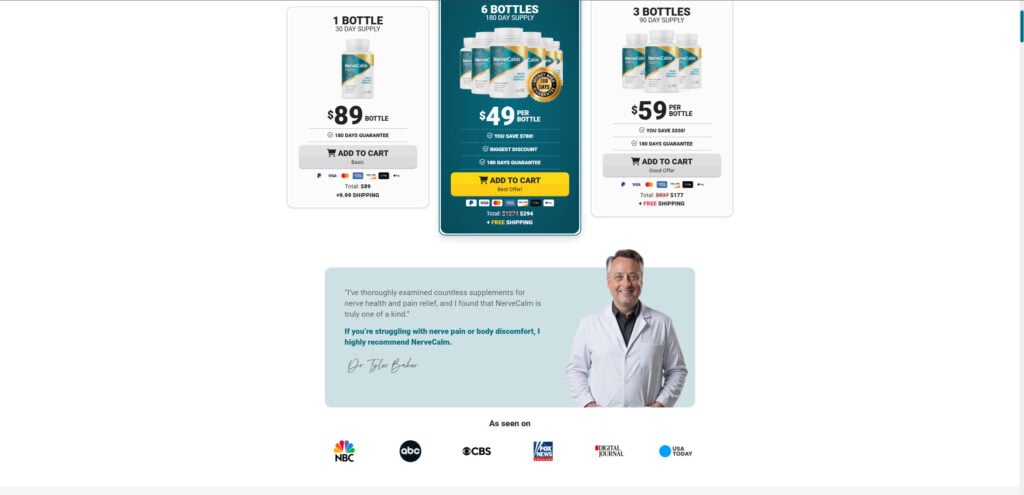Is NerveCalm truly the natural solution for nerve pain it claims to be? Or is it just another supplement riding the wave of health hype and false promises? With so many people struggling with neuropathy, it’s easy to see how a product claiming fast relief and full nerve repair might attract attention. But before you spend a dime, it’s worth digging deeper. In this article, we’ll explore whether NerveCalm lives up to its claims—or if it’s just another cleverly marketed useless supliment.

NerveCalm Overview
NerveCalm is marketed as a “nerve calming formula” made from 100% natural ingredients, claiming to eliminate nerve toxins, relieve pain, and repair damaged nerves. It promises fast-acting results and even throws in the backing of a doctor recommendation. But when you take a closer look, the foundation of these claims starts to crumble.
1. Exaggerated Medical Claims
Many red flags pop up when you evaluate NerveCalm’s marketing strategy. Promises like “fast-acting relief,” “nerve repair,” and “toxin elimination” are bold—too bold for a supplement that lacks published clinical trials. Most legitimate treatments for nerve damage or neuropathy are gradual and require long-term medical management. Claiming that herbs can repair nerves quickly isn’t just misleading—it borders on deceptive.
2. Lack of Clinical Evidence
The ingredients in NerveCalm, including Corydalis Yanhusuo, California Poppy Seed, and Opuntia Phaeacantha, may have mild anti-inflammatory or calming effects, but there is no robust scientific evidence supporting their ability to regenerate nerve tissue. The site offers no published peer-reviewed studies, nor does it link to clinical research verifying its claims.
3. Ambiguous Doctor Endorsement
A white-coated individual named “Dr. Tyler Becker” is used to endorse the product, claiming it to be “one of a kind.” However, there is no verifiable information about this doctor—no medical license, no practice details, and no presence in academic or clinical circles. This lack of transparency is a red flag. It’s possible this endorsement is fabricated or highly exaggerated.
4. Manipulative Sales Tactics
The website aggressively promotes upselling, urging users to buy 6 bottles to receive the biggest discount. There’s a countdown timer and repeated claims like “FREE SHIPPING” and “100% Satisfaction Guaranteed” to create a sense of urgency. These are common tactics used in digital marketing scams to pressure users into impulse buying.
5. Overuse of Trust Signals
Buzzwords like “FDA-registered facility,” “non-GMO,” and “gluten-free” are plastered throughout the site. While these terms might sound reassuring, they’re often used to gloss over the absence of actual clinical support. It’s important to note that the FDA does not approve dietary supplements, and being manufactured in a registered facility doesn’t guarantee efficacy or safety.
6. Cherry-Picked Reviews and Ratings
The site claims a 4.8-star rating from over 20,000 users, but only 14 reviews are shown. This inconsistency suggests manipulation. It’s a common scam strategy to feature hand-picked testimonials while burying negative reviews. Real transparency would include verified reviews from third-party platforms like Amazon or Trustpilot.
7. Hidden Behind Proprietary Blends
While the product lists active ingredients, the dosages are hidden within proprietary blends. This makes it impossible to evaluate whether the amounts included are clinically meaningful. Consumers can’t tell if they’re getting an effective dose—or just trace amounts.
8. Unclear Company Background
There’s no clear information about the manufacturer behind NerveCalm. No physical address, no phone number, and limited customer service options. When dealing with health products, transparency is critical. If a company can’t be held accountable, it’s a major red flag.
How the NerveCalm Operation Works
Understanding how the NerveCalm marketing and sales funnel works can help you avoid falling into the trap. Here’s how the scam-like process unfolds:
Step 1: High-Pressure Advertising
It usually starts with a flashy ad, often on social media or through a clickbait-style article. These ads use emotionally charged language like “miracle cure” or “doctor-approved natural fix for nerve pain.”
Step 2: Trust-Building Through Fake Endorsements
Upon clicking, you’re taken to a website featuring a smiling doctor, often with a quote endorsing the product. You’ll see trust logos (NBC, CBS, USA Today) that give the impression of credibility, even though there’s no proof the product has been featured by these outlets.
Step 3: Promises of Scarcity and Exclusivity
You’ll encounter claims like “only 14 bottles left” or “offer ends in 3 minutes.” This creates panic buying behavior—designed to make you act fast without thinking it through.
Step 4: Discount Bait
The site offers deep discounts for buying in bulk (e.g., 6 bottles at $49 each). But this tactic is designed to trap you into a high-value purchase, making it harder to walk away even if you’re skeptical.
Step 5: Auto-Ship Enrollments (in some cases)
Some reports from similar supplement offers have included fine print about auto-renewal or monthly shipments. You may unknowingly sign up for recurring billing if you don’t read the terms carefully.
Step 6: Difficult Refund Process
Although the site claims a “180-Day Money Back Guarantee,” reviews often mention that refunds are hard to obtain. Customer service may be unresponsive or request excessive documentation before approving a return.
Step 7: No Follow-Up Support
After the sale, the company usually goes silent. You won’t find follow-up care, clear dosage instructions, or access to real support. And since there’s no verifiable company behind the brand, you’re often left with no recourse.
What to Do If You’ve Fallen Victim to This Scam
If you believe you’ve been misled by NerveCalm or made a purchase you regret, take immediate action to minimize damage and potentially get your money back:
- Contact Customer Support Immediately
- Visit the NerveCalm website and reach out using their contact form or email. Request a refund in writing and keep a record of all correspondence.
- File a Dispute With Your Credit Card Company
- Most credit card providers allow chargebacks for fraudulent or misleading purchases. Call your issuer and explain the situation.
- Document Everything
- Save screenshots of the website, your order confirmation, and any emails exchanged. This documentation will be essential for refund claims or legal action.
- Report the Scam
- Report to the Federal Trade Commission (FTC) at reportfraud.ftc.gov.
- File a complaint with the Better Business Bureau (BBB).
- Notify the FDA’s MedWatch if you experienced adverse effects.
- Monitor Your Bank and Credit Accounts
- Watch for unauthorized transactions. If you see recurring charges, cancel your card and request a new one.
- Warn Others
- Leave an honest review on platforms like Trustpilot, Amazon, or Reddit to help others avoid the same mistake.
- Consult a Medical Professional
- If you’ve taken NerveCalm and are experiencing side effects, talk to your doctor. Some “natural” ingredients can interact with medications or cause health issues.
The Bottom Line
So, is NerveCalm a scam? While it may not be an outright fraud, it exhibits many classic signs of a deceptive marketing operation. From exaggerated health claims and vague endorsements to a lack of scientific backing and aggressive upselling, it’s clear that consumers should approach this product with extreme caution.
If you’re struggling with nerve pain, talk to a licensed medical professional. Don’t rely on supplements that promise miracles but deliver uncertainty. In health, transparency, clinical support, and accountability should always come first.
When it comes to NerveCalm, the safest move is not to click “buy”—but to dig deeper, ask questions, and make informed decisions.










